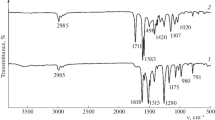Abstract
The evolution of the acid/base properties of a series of oxide supports (alumina, magnesia and silica) modified by increasing loadings of additive ions (Li+, Ni2+, and SO4 2-) from 1 to 50% of the support surface coverage is reported using the catalytic test of isopropanol decomposition, studied as a function of the reaction temperature. The calculated kinetic parameters Ea, A, and ΔS≠ permit interpretation of the reaction mechanism with relation to the acidity/basicity of the modified surfaces. The series of alumina oxides, due to the amphoteric properties of the surfaces, decomposed isopropanol through an E2 mechanism leading to propene and di-isopropyl ether formation. The selectivity to the two products was dependent on the strength of the basicity (addition of lithium and nickel) or on the acidity (addition of sulfate) of the surfaces. Magnesia series oxides dehydrated isopropanol through an E1b mechanism due to the presence of very strong basic surfaces possessing some weak acid sites. The very weak amphoteric character of silica was strengthened by the loading of the three additives; the modified silica surfaces displayed enhanced decomposition activity with respect to pure silica.
Similar content being viewed by others
References
K. Tanabe, in: Catalysis, Science and Technology, Vol. 8, eds. J.R. Anderson and M. Boudart (Springer, Berlin, 1987) pp. 232–271.
Y. Chen and L. Zhang, Catal. Lett. 12 (1992) 51.
A. Gervasini, G. Bellussi, J. Fenyvesi and A. Auroux, J. Phys. Chem. 99 (1995) 5117.
A. Gervasini, G. Bellussi, J. Fenyvesi and A. Auroux, in: New Frontiers in Catalysis, Proc. 10th Int. Congr. on Catalysis, eds. L. Guczi, F. Solymosi and P. Tétényi (Elsevier, Amsterdam, 1993) pp. 2047–2050.
N.A. Youssef and A.M. Youssef, Bull. Soc. Chim. Fr. 128 (1991) 864.
A. Gervasini and A. Auroux, J. Catal. 131 (1991) 190.
M. Ai, J. Catal. 52 (1978) 16.
K. Tanabe, M. Misono, Y. Ono and H. Hattori, in: New Solid Acids and Bases, Their Catalytic Properties, Vol. 51, eds. B. Delmon and J.T. Yates (Elsevier, Amsterdam, 1989).
A. Gervasini, J. Fenyvesi and A. Auroux, Langmuir (1996), to be published.
K. Jiràtovà and L. Berànek, Appl. Catal. 2 (1982) 125.
V. Perrichon and M.C. Durupty, Appl. Catal. 42 (1988) 217.
A. Amin, S. Hanafi and S.A. Selim, Thermochim. Acta 53 (1982) 125.
R.D. Shannon, Acta Cryst. 32 (1976) 751.
J. Cunningham, B.K. Hodnett, M. Ilyas, E.L. Leahy and J.L.G. Fierro, Faraday Discussions Chem. Soc. 72 (1981) 283.
M.Ai, Bull. Chem. Soc. Jpn. 50 (1977) 2579.
H. Nollery and G. Ritter, J. Chem. Soc. Faraday Trans. I 80 (1984) 275.
J.C. Luy and J.M. Parera, Appl. Catal. 26 (1986) 295.
H.Knözinger and A. Scheglila, J. Catal. 17 (1970) 252.
V.R. Padmanabhan and F.J. Eastburn, J.Catal. 24 (1972) 88.
I. Halasz, H. Vinek, K. Thomke and H. Noller, Z. Phys. Chem. NF 144 (1985) 157, and references therein.
E. Akiba, M. Soma, T. Onishi and K. Tamaru, Z. Phys. Chem. 119 (1980) 103.
K.C. Waugh, M. Bowker, R.W. Petts, H.D. Vandervell and J. O'Malley, Appl. Catal. 25 (1986) 121.
H. Knözinger, H. Buhl and E. Ress, J. Catal. 12 (1968) 121.
J.W. Moore and R. Pearson, in: Kinetics and Mechanism (Wiley, New York, 1981) pp. 177–181.
P.H. Emmett and S. Brunauer, J. Am. Chem. Soc. 59 (1937) 1553.
H. Knözinger, H. Buhl and K. Kochloefl, J. Catal. 24 (1972) 57
A. Auroux and A. Gervasini, J. Phys. Chem. 94 (1990) 6371
A. Gervasini and A. Auroux, J. Phys. Chem. 97 (1993) 2628
Rights and permissions
About this article
Cite this article
Gervasini, A., Fenyvesi, J. & Auroux, A. Study of the acidic character of modified metal oxide surfaces using the test of isopropanol decomposition. Catalysis Letters 43, 219–228 (1997). https://doi.org/10.1023/A:1018979731407
Issue Date:
DOI: https://doi.org/10.1023/A:1018979731407




